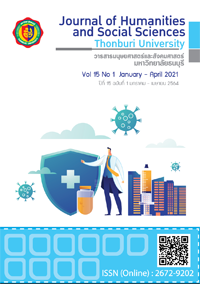Youth Empowerment for the Protection of Endangered Species in Thailand: A Case Study of Fighting Extinction Project
Keywords:
Youth Empowerment, Endangered Species, Fighting Extinction Project, ThailandAbstract
The objectives of this study are to explore the youth empowerment for the protection of endangered species in Thailand by studying case of Fighting Extinction Project and to propose directions to enhance youth empowerment in environmental education in Thailand. Qualitative approach was employed. Data was collected through in-depth interviews with 10 key informants from Environmental Education Centre (EEC) Thailand, environmental experts, youth experts, and parents of youths who participated in Fighting Extinction Project. The main finding is that the Fighting Extinction Project was complied with four dimensions of youth empowerment; 1) involvement value and participation, 2) warmth and safe surrounding, 3) sharing power equally between youth and adult, and 4) integrated individual and community potential. However, there were still a gap between theory and practice in relations to participation in reflection of opinion essential for procedures between individual and political process, and participation in political process leading to changes. Two major recommendations were drawn from this study. Firstly, this study suggested the environmental educators to enhance field study in the course syllabus. Secondly, new forms of political activities such as environmental advocacy and environmental harm product boycott should be promoted in environmental education because these political activities empower the youth and lead to powerful social change.
References
Brandli, L. L., Salvia, A. L., da Rocha, V. T., Mazutti, J., & Reginatto, G. (2020). The Role of Green Areas in University Campuses: Contribution to SDG 4 and SDG 15. In Leal Filho W. et al. (Ed.), Universities as Living Labs for Sustainable Development: Supporting the Implementation of the Sustainable Development Goals (pp. 47-68). Cham: Springer International Publishing.
Browne, L. P., Garst, B. A., & Bialeschki, M. D. (2011). Engaging youth in environmental sustainability: Impact of the Camp 2 Grow program. Journal of Park Recreation Administration, 29(3), 70-85.
Department of Marine and Coastal Resources. (2014). Last Gasp for Biodiversity. Retrieved August 1, 2020, from https://www. dmcr.go.th/detailAll/1829/rn/0
Eagan, D. J., Keniry, J., & Schott, J. (2008). Higher education in a warming world. Retreived August 2, 2020, from http:// www. restondigital.com/coolcounties/HigherEducationinaWarmingWorld.pdf.
EEC Thailand. (2020). About EEC Thailand. https://eecthailand.com/about-eec/
Eisman, A. B., Zimmerman, M. A., Kruger, D., Reischl, T. M., Miller, A. L., Franzen, S. P., & Morrel‐Samuels, S. (2016). Psychological empowerment among urban youth: Measurement model and associations with youth outcomes. American journal of community psychology, 58(3-4), 410-421.
Finlay, J., & Massey, J. (2012). Eco-campus: Applying the ecocity model to develop green university and college campuses. International Journal of Sustainability in Higher Education, 13(2), 150-165.
Fulford, S., & Thompson, S. (2013). Youth community gardening programming as community development: The youth for ecoaction program in Winnipeg, Canada. Canadian journal of nonprofit social economy research, 4(2), 56-75.
Gallagher, J., Wheeler, C., McDonough, M., & Namfa, B. (2000). Sustainable environmental education for a sustainable environment: Lessons from Thailand for other nations. In B. S. (Ed.), Environmental Challenges (pp. 489-503). Dordrecht: Springer.
Hacking, E. B., Scott, W., & Barratt, R. (2007). Children’s research into their local environment: Stevenson’s gap, and possibilities for the curriculum. Environmental Education Research, 13(2), 225-244.
IUCN Thailand Programme. (2016). An Overview of IUCN Thailand. Retrieved July 11, 2020, from https://www.iucn.org/ sites dev/files/content/documents/iucn-thai_facts_may-16.pdf
Jennings, L. B., Parra-Medina, D. M., Hilfinger-Messias, D. K., & McLoughlin, K. (2006). Toward a critical social theory of youth empowerment. Journal of Community Practice, 14(1-2), 31-55.
Kaewmong, P., Chiakwathanyu, C., Chantra, R., Kanghae, H., & Kittiwattanawong, K. (2016). Marine endangered species status and crisis in Thailand. Thai Journal of Veterinary Medicine, 46 (Supplement).
Nisbet, E. K., & Zelenski, J. M. (2011). Underestimating nearby nature: Affective forecasting errors obscure the happy path to sustainability. Psychological science, 22(9), 1101-1106.
Pearrow, M. M. (2008). A critical examination of an urban-based youth empowerment strategy: The teen empowerment program. Journal of Community Practice, 16(4), 509-525.
Percy-Smith, B., & Burns, D. (2013). Exploring the role of children and young people as agents of change in sustainable community development. Local Environment, 18(3), 323-339.
Russell, C. L. (1999). Problematizing nature experience in environmental education: The interrelationship of experience and story. Journal of Experiential Education, 22(3), 123-137.
Sloam, J. (2007). Rebooting democracy: Youth participation in politics in the UK. Parliamentary affairs, 60(4), 548-567.
UNDP Thailand. (2020). Goal 15: Life on land. Retrieved July 30, 2020, from https://www.th.undp.org/content /thailand/ en/home/sustainable-development-goals/goal-15-life-on-land.html
UNEP. (2020a). GOAL 15: Life on land. Retrieved August 1, 2020, from https://www.unenvironment.org/explore-topics/ sustainable-development-goals/why-do-sustainable-development-goals-matter/goal-15
UNEP. (2020b). Promoting the sustainability of terrestrial ecosystems and halting desertification, land degradation, and biodiversity loss. Retrieved August 5, 2020, from https://wedocs.unep.org/bitstream/handle/ 20.500.11822/25765/ SDG15_Brief.pdf?sequence=1&isAllowed=y
United Nations. (2020). Goal 15: Protect, restore and promote sustainable use of terrestrial ecosystems, sustainably manage forests, combat desertification, and halt and reverse land degradation and halt biodiversity loss. Retrieved July 29, 2020, from https://unstats.un.org/sdgs/report/2016/goal-15/
Wang, C. C. (2006). Youth participation in photovoice as a strategy for community change. Journal of community practice, 14(1-2), 147-161.
Zimmerman, M. A., Stewart, S. E., Morrel-Samuels, S., Franzen, S., & Reischl, T. M. (2011). Youth empowerment solutions for peaceful communities: Combining theory and practice in a community-level violence prevention curriculum. Health Promotion Practice, 12(3), 425-439.







